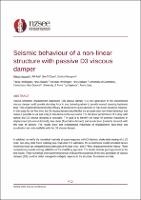Seismic behaviour of a non-linear structure with passive D3 viscous damper

Download
Date
2021-04-14Authors
Hazaveh, Nikoo
Rad, Ali
Chase, Geoff
Pampanin, Stefano
Metadata
Show full item recordAbstract
Passive Direction Displacement Dependent (D3) viscous damper is a next generation of the conventional viscous damper could provide damping force in any desired quadrant to provide wanted damping hysteresis loop. This research demonstrates the efficacy of passive D3 viscous dampers in non-linear structures response. In this study for the first time, the D3 viscous damper modelled for the structure with non-linear behaviour that makes it possible to use and analyze this device in the real world. The structural performance of 2-story with typical and D3 viscous damping is evaluated. The goal is to identify the range of potential reductions in displacement (structural demand), base shear (foundation demand) and acceleration (contents demand) with this type of devices. The results show that simultaneous reductions of displacement, base-shear and acceleration are only available with the D3 viscous damper.
In addition, to verify the numerical methods structure response with D3 devices, shake table testing of a 1/2 scale, two-story steel frame building was conducted. For validation, the experimental model simulated device hysteresis loops are compared along with peak drift, base shear, and 2nd floor displacement time history. These comparisons provide a strong validation of the modelling approach. The results indicate good agreement to the test results. These numerical and experimental results indicate the robustness of the new generation of viscous dampers (D3) could be better managed to mitigate response to the structure, foundation and risk.
